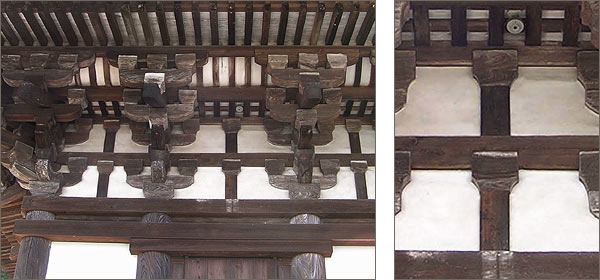|
||
 |
||

Taimadera
Saitou 当麻寺西塔 (Nara)
(C)2001 Japanese Architecture and Art Net Users System. No reproduction or republication without written permission.
掲載のテキスト・写真・イラストなど、全てのコンテンツの無断複製・転載を禁じます。
|
||||||
| kentozuka 間斗束 | ||||||
| KEY WORD : architecture / general terms | ||||||
| A strut composed of a short post surmounted by a
bearing block *masu 斗. It
is placed on the head-penetrating tie beam *kashiranuki
頭貫, that is inserted into and stretches between pillars *ken
間 literally means space, and here it refers to the interval between two bracket
complexes. Positioned at the center of this space, it adds support to the long
bracket tie beam *tooshihijiki
通肘木, carried by the bracket complexes atop the pillars. See *nakazonae
中備. If the bracket complexes are 3-stepped *mitesaki
tokyou 三手先斗きょう, a second strut capped with a bearing block is set on the
bracket-tie beam directly above the one on the head-penetrating tie beam to add
support for the wall purlin *gawageta
側桁. Kentozuka are structurally functional struts used from the 7c through
the 12c. Toward the latter part of the 13c, the strut was capped with a bearing
block and began to be widened at the base to resemble the shape of a shamisen
三味線. This was called *bachizuka
撥束. By the 15c, this strut became more decorative and is now called *minozuka
蓑束. It has flaring sides and a somewhat frilly collar carved at the top. In the
early Kamakura period, in Houkaiji Amidadou 法界寺阿弥陀堂, Kyoto, plant
motifs were painted on the walls on each side of kentozuka. Eventually,
such decorative motifs on each side of a strut became popular and this carving
was called *oigata mon'you 笈形文様. This strut is triangular and forms a transition between
the verticality of the strut and the horizontal beam on which the strut is set.
|
||||||
 Taimadera
Saitou 当麻寺西塔 (Nara)
|
||||||
| REFERENCES: | ||||||
| *tsuka 束, *taiheizuka 大瓶束 | ||||||
| EXTERNAL LINKS: | ||||||
| NOTES: | ||||||
(C)2001 Japanese Architecture and Art Net Users System. No reproduction or republication without written permission. 掲載のテキスト・写真・イラストなど、全てのコンテンツの無断複製・転載を禁じます。 |
||||||